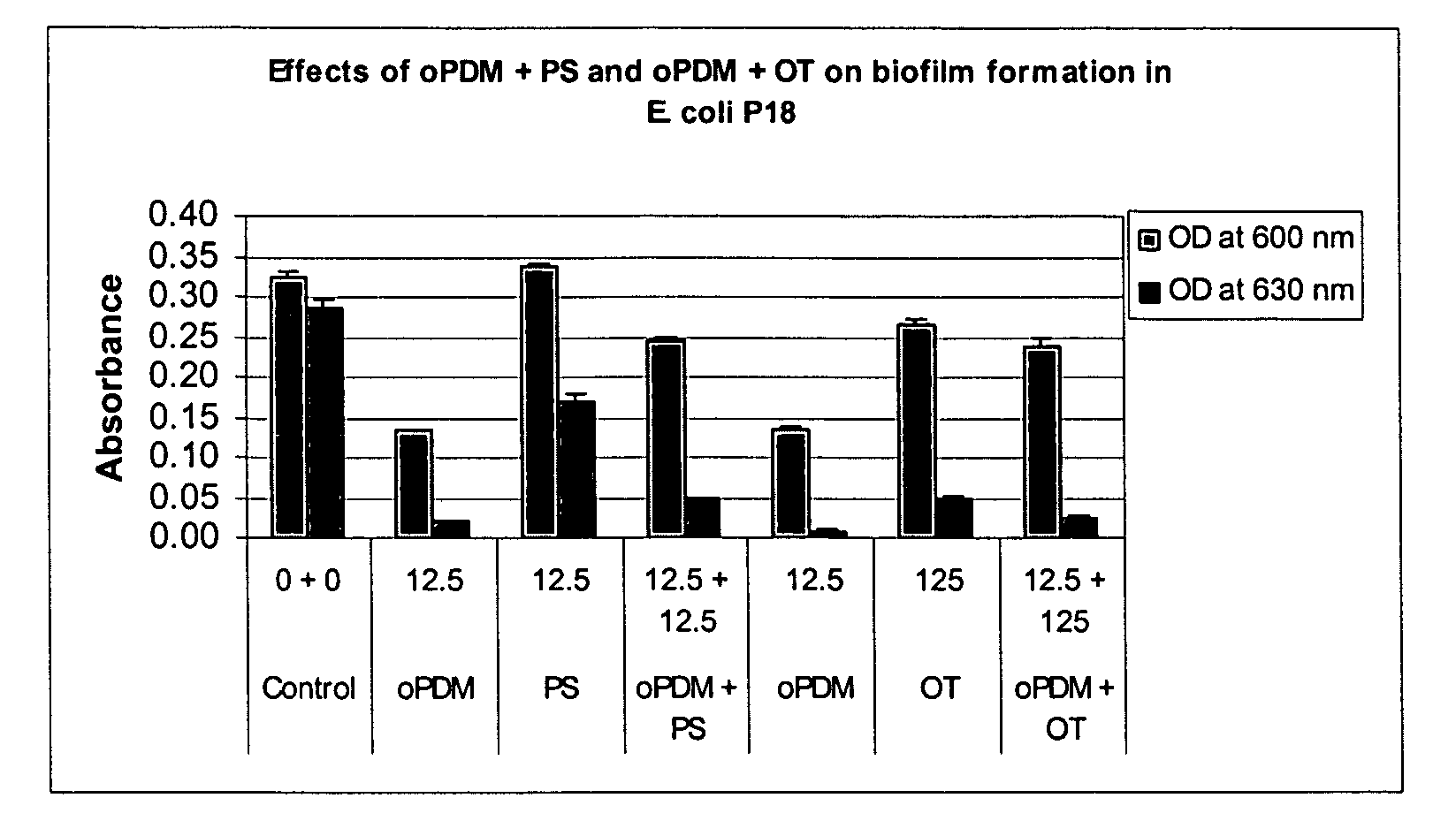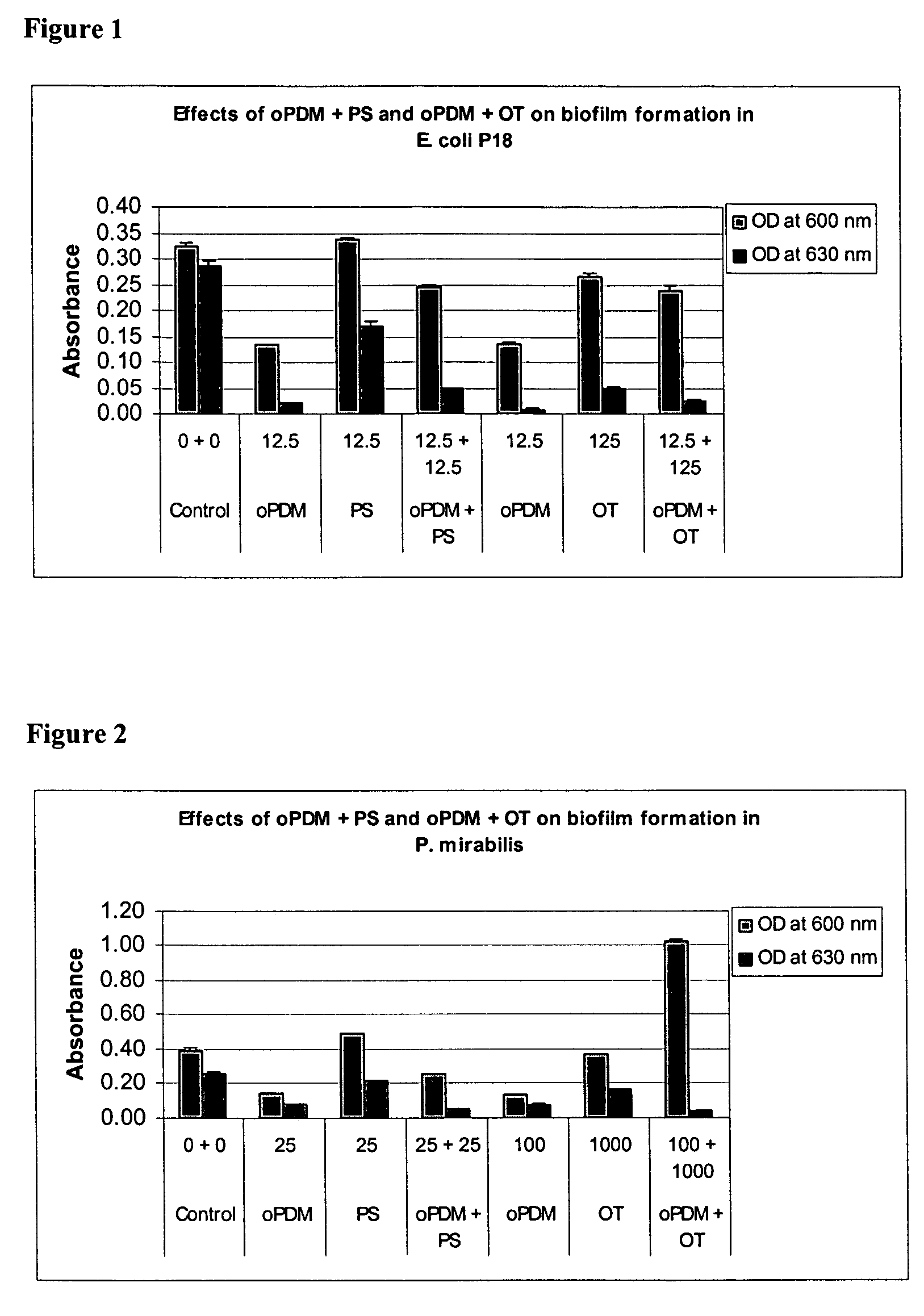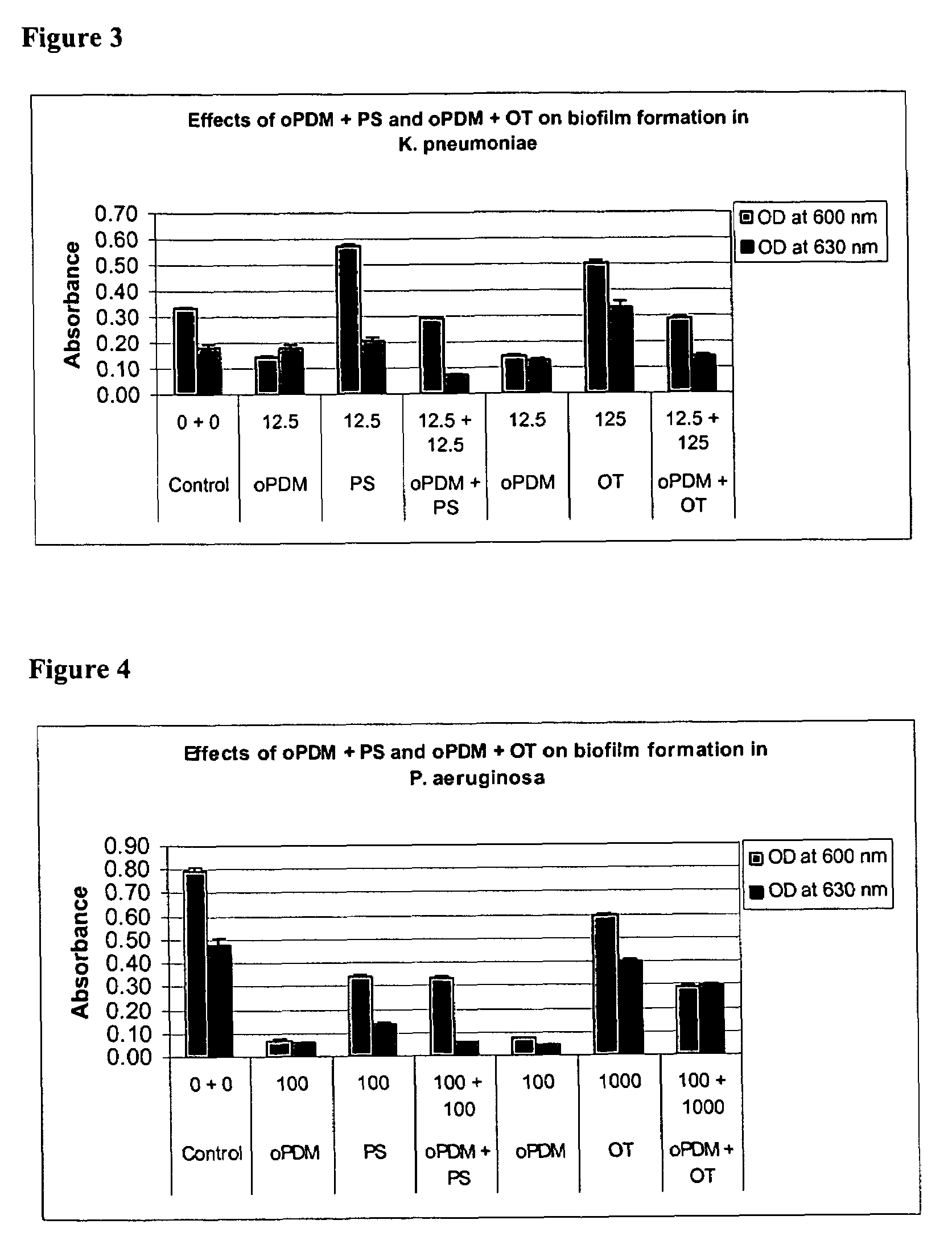Synergistic antimicrobial compositions and methods for reducing biofilm formation
a technology of compositions and antimicrobial compositions, applied in the direction of prosthesis, catheters, peptide/protein ingredients, etc., can solve the problems of difficult or impossible elimination, limited drug incorporation mass, and public health problems
- Summary
- Abstract
- Description
- Claims
- Application Information
AI Technical Summary
Benefits of technology
Problems solved by technology
Method used
Image
Examples
example 1
Synergistic Effects of N,N′-(1,2-phenylene) dimaleimide (oPDM)+protamine sulfate (PS), PDM+ovotransferrin (OT), N-(1-pyrenyl) maleimide (PvrM)+PS and PyrM+OT on Biofilm Formation in Catheter-Associated Bacteria
[0107]Catheter-associated bacterial strains used: E. coli P18, Proteus mirabilis, Klebsiella pneumoniae, Pseudomonas aeruginosa, Enterococcus faecalis and Staphylococcus epidermidis. Concentrations of oPDM, PyrM, PS and OT alone and in combinations used for screening are given in Table 1.
[0108]
TABLE 1Concentrations of oPDM, PyrM, PS and OT alone and in combinations usedfor screening (μg / ml of DMSO)1CompoundE. coliP. mirabilisK. pneumoniaeP. aeruginosaE. faecalisStaph. epidermidisoPDM12.52512.510012.550PS12.52512.510012.550oPDM + PS12.5 + 12.525 + 2512.5 + 12.5100 + 10012.5 + 12.550 + 50oPDM12.510012.510012.525OT12510001251000125250oPDM + OT12.5 + 125 100 + 100012.5 + 125 100 + 100012.5 + 125 25 + 250PyrM12.525255010025PS12.525255010025PyrM + PS12.5 + 12.525 + 2525 + 2550 + ...
example 2
Effects of oPDM)+PS, oPDM+OT, PvrM+PS and PvrM+OT Combinations on Biofilm Formation in Catheter-Associated Bacteria
[0112]Catheter-associated bacterial strains used: E. coli P18, Proteus mirabilis, Pseudomonas aeruginosa, Klebsiella pneumoniae, Enterococcus faecalis and Staphylococcus epidermidis.
[0113]Method: Base Formulas for N,N′-(1,2-phenylene) dimaleimide (oPDM), N-(1-pyrenyl) maleimide (PyrM), Protamine Sulfate (PS) and Ovotransferrin (OT) were prepared as described in Table 2.
[0114]
TABLE 2Base Formulas for Screening (μg / ml of DMSO)CompoundABCDoPDM + PS12.5 + 12.525 + 2550 + 50100 + 100oPDM + OT12.5 + 125 25 + 250 50 + 500 100 + 1000PyrM + PS12.5 + 12.525 + 2550 + 50100 + 100PyrM + OT12.5 + 125 25 + 250 50 + 500 100 + 1000
[0115]Studies were conducted to test biofilm formation in microtiter plate wells. Quantitative biofilm assay for catheter-associated bacteria was standardized following the procedure described by Jackson, et al. (J. Bacteriol. 184: 290–301). Bacteria were r...
example 3
Effect of oPDM+PS Coating on the Adherence of Catheter-Associated Bacteria to Urinary Catheter
[0117]Catheter-associated bacterial strains used: E. coli P18, Proteus mirabilis, Klebsiella pneumoniae, Pseudomonas aeruginosa, Enterococcus faecalis and Staphylococcus epidermidis.
[0118]Method: All-silicone foley catheter segments (3 cm sections of tubing) that had been preheated (incubated in sterile water at 65° C. overnight and air dried) were immersed in oPDM+OT solution (50 μg oPDM+50 μg OT per ml of DMSO) at 45° C. for two hours and air dried under aseptic conditions. The control catheter segments were immersed in DMSO at 45° C. for two hours and air dried under aseptic conditions. Both control and treated segments were immersed in tryptic soy broth cultures of E. coli, Proteus mirabilis, Klebsiella pneumoniae, Pseudomonas aeruginosa, Enterococcus faecalis and Staphylococcus epidermidis (1%) for 3 hours at 37° C. The catheter segments were washed 3 times in 3 changes of sterile sal...
PUM
| Property | Measurement | Unit |
|---|---|---|
| time | aaaaa | aaaaa |
| temperature | aaaaa | aaaaa |
| temperature | aaaaa | aaaaa |
Abstract
Description
Claims
Application Information
 Login to View More
Login to View More - R&D
- Intellectual Property
- Life Sciences
- Materials
- Tech Scout
- Unparalleled Data Quality
- Higher Quality Content
- 60% Fewer Hallucinations
Browse by: Latest US Patents, China's latest patents, Technical Efficacy Thesaurus, Application Domain, Technology Topic, Popular Technical Reports.
© 2025 PatSnap. All rights reserved.Legal|Privacy policy|Modern Slavery Act Transparency Statement|Sitemap|About US| Contact US: help@patsnap.com



